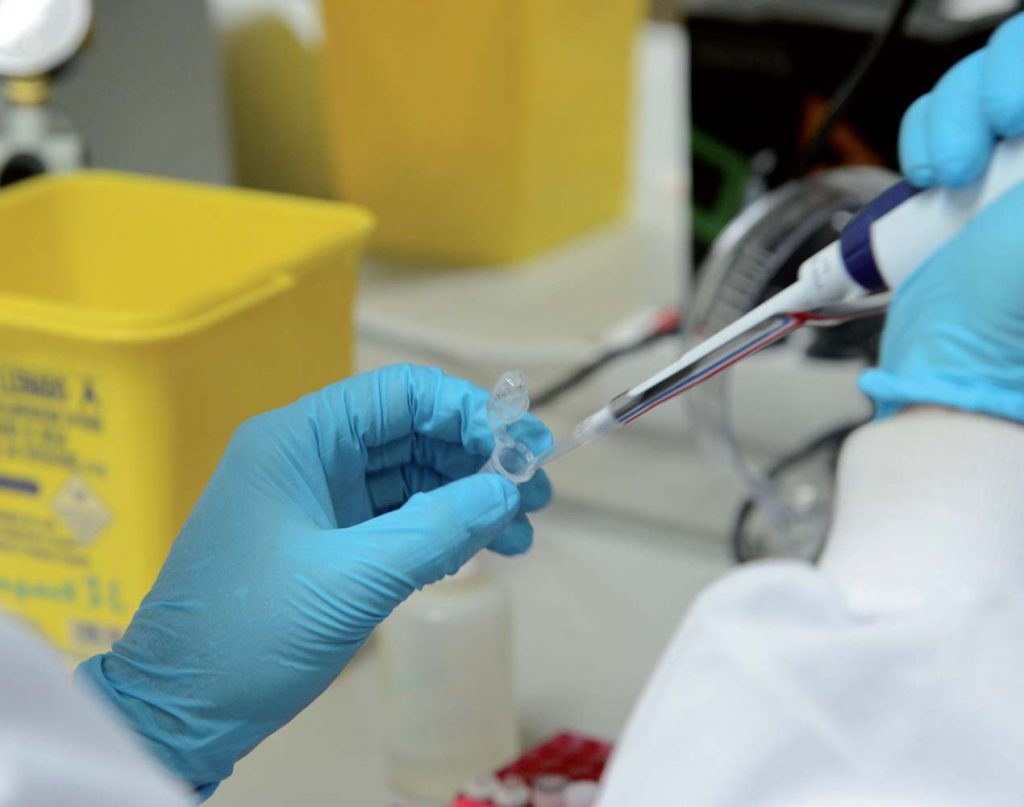ÁMBITO EUROPEO
Innovación: la batalla pendiente
Si queremos tener una oportunidad en la carrera tecnológica contra China y Estados Unidos harán falta más recursos y coordinación.
Europa opina
Informe de Desempeño de Ciencia, Investigación e Innovación 2020, de la Comisión Europea (en inglés).
Información del Parlamento Europeo sobre la política de innovación de la UE.
Informe de Bruegel sobre el futuro de la relación entre la UE y el Reino Unido en el campo de la investigación y la innovación (en inglés).

La ciencia y la innovación son la base para el desarrollo tecnológico y la transformación ecológica que necesita Europa para superar la crisis del Covid-19 y prosperar en el futuro. Sin embargo, la UE todavía encara batallas pendientes en este campo, aún más urgentes tras el impacto de la pandemia.
JORGE VALERO
EL MOVIMIENTO de acción-reacción es automático. Tan pronto como una crisis golpea, gobiernos y expertos miran a la ciencia para prometer una recuperación rápida y un futuro más próspero. Lo mismo ha sucedido con la pandemia del Covid-19. Más aún porque el virus no solo ha provocado una recesión descomunal en Europa, la mayor en las casi siete décadas de historia de la UE, sino también un desafío sanitario en el que la ciencia y la innovación están siendo el principal frente de batalla en la lucha contra el patógeno.
El coronavirus ha mostrado las fortalezas y debilidades en nuestro ecosistema científico e innovador. Y ha amplificado la advertencia que los expertos, científicos, emprendedores y autoridades llevan años repitiendo con pocos resultados. Europa brilla en el campo científico, pero debe dar un impulso más decidido para transformar ese conocimiento en impacto. Más aún, si queremos tener una oportunidad en la carrera tecnológica contra China y Estados Unidos, y mantener el calentamiento global por debajo de los dos grados, harán falta más recursos y coordinación.

“La investigación y la innovación son el núcleo de la respuesta a la crisis sin precedentes que encaramos y pueden contribuir significativamente a la recuperación económica”, señaló el pasado 27 de mayo la comisaria de Innovación e Investigación, Mariya Gabriel.
La búlgara presentó entonces el Informe sobre el Rendimiento de Ciencia, Investigación e Innovación 2020, un trabajo bienal que muestra «cómo la investigación y la innovación son fundamentales para lograr las transiciones ecológicas y digitales que Europa necesita”, añadió.
El documento muestra las luces del sistema europeo, y sobre todo aquellos campos en los que necesita mejorar. Y ofrece 11 recomendaciones para apuntalar el sistema, sobre todo teniendo en cuenta la agenda digital y ‘verde’.
Y habrá recursos para poner estas ideas en práctica. Para el próximo presupuesto plurianual de la UE (2021-2027) la Comisión Europea ha propuesto 100.000 millones de euros para su programa de innovación Horizonte Europa para los próximos siete años, su programa para apoyar la investigación, la ciencia y la innovación.
Los europeos lideran la investigación en temas de sostenibilidad, con un cuarto del total de estudios publicados y de patentes
La situación. Aun así, la lluvia de millones se puede quedar corta para dar el impulso que Europa necesita, no solo respecto a sus necesidades sino también al comportamiento de sus principales competidores: Estados Unidos y China.
Europa invierte en I+D un 2,19% de su PIB (1,45% de inversión privada), según recuerda la Comisión. Es el mismo porcentaje que destina China. Sin embargo, su volumen total es mucho mayor, dado el tamaño de su economía, y lleva una trayectoria ascendente mucho más pronunciada que el lento progreso de los europeos. Por su parte, EE.UU. dedica un 2,83% de su PIB, siendo sus empresas responsables del 2,05%. Lejos quedan países como Corea del Sur, con una inversión de 4,53% de su PIB.
Recomendaciones de la Comisión Europea
EL Informe sobre el Rendimiento de Ciencia, Investigación e Innovación 2020 de la Comisión incluyó una serie de propuestas, agrupadas en cuatro campos, para mejorar nuestro sistema innovador, y nuestro ecosistema de I+D sobre el que se asienta. Las medidas son:
- El Acuerdo Verde Europeo requiere un cambio hacia una política de innovación transformadora.
- Asegurarse de que el crecimiento no deje a nadie atrás: personas, regiones, países y empresas.
- Equipar a los europeos con las habilidades para navegar por un mundo cambiante.
- Avance rápido hacia la igualdad de género y mediante el I+D.
- Dar forma a la ventaja competitiva de Europa en la carrera mundial por la tecnología.
- Modernización de la política de I+D para adaptarla a su propósito en la era digital.
- Garantizar el liderazgo científico y estimular los flujos de conocimiento dentro de la UE.
- Construir un ecosistema de I+D vibrante y resistente en la era posterior a Siemens-Alstom (la fusión de los fabricantes de trenes europeos prohibida por Bruselas).
- Maximizar el valor de los resultados de I+D para la sociedad, la economía y la política.
- Hacer que la regulación de la UE sea amigable con la innovación y con visión de futuro.
- Anticipar el mundo futuro a través de una mejor evidencia para la política.
Estas recomendaciones se interpretan a través “del doble desafío de las transiciones verdes y digitales para conseguir una economía moderna, eficiente en recursos y competitiva”, señala el informe de la Comisión.
El objetivo que se persigue es garantizar la sostenibilidad, entendida de manera amplia (medioambiental, social y económica), impulsando la competitividad.
“La competitividad de Europa debe basarse en un marco de instituciones, políticas y factores que garanticen la sostenibilidad a largo plazo (competitividad sostenible), y la sostenibilidad debe convertirse en un impulsor clave de la competitividad y el crecimiento de Europa (sostenibilidad competitiva)”, añade el documento.
European Commission recommendations
The Commission’s 2020 Science, Research and
Innovation Performance Report included a series of
proposals, grouped into four fields, to improve our
innovation and R&D ecosystem:
- The European Green Deal requires a shift
towards a transformative innovation policy. - Making sure that growth does not leave anyone
behind… people, regions, countries and firms. - Equipping Europeans with the skills to
navigate the changing world. - Fast-forwarding to gender equality in and
through R&I. - Shaping Europe’s competitive edge in the
global race for technology. - Modernising R&I policy to make it fit for
purpose in the digital age. - Ensuring scientific leadership and stimulating
knowledge flows within the EU. - Building a vibrant and resilient R&I ecosystem
in the post-Siemens-Alstom era. - Maximising the value of R&I results for
society, the economy and policy. - Making the EU’s regulation innovation-friendly
and forward-looking. - Anticipating the future world through better
evidence for policy.
These recommendations are seen through «the double challenge of green and digital transitions to achieve a modern, resource-efficient and competitive economy,» the Commission report said.
The objective is to guarantee sustainability in a broad sense (environmental, social and economic), and promoting competitiveness.
“Europe’s competitiveness should build on a framework of institutions, policies and factors that ensure sustainability in the long term (sustainable competitiveness), and sustainability should become a key driver of Europe’s competitiveness and growth (competitive sustainability),” the document adds.
in English
Innovation: the outstanding battle
Science and innovation are the basis for the technological development and ecological transformation that Europe needs to overcome the Covid-19 crisis and to prosper in the future. But the EU is still facing outstanding battles in this field, as they became even more urgent in the aftermath of the coronavirus pandemic.
The action-reaction movement is automatic. As soon as a crisis hits, governments and experts refer to science and innovation to promise a speedy recovery and a brighter future. That was the case with the Covid-19 crisis with more reason. The deadly virus will not only trigger the deepest recession in the EU’s seven-decade history, but also science and innovation have been at the forefront in the fight against the pathogen.
The coronavirus pandemic has shown the strengths and weaknesses in the European scientific and innovation ecosystem. It amplified the warnings given by experts, scientists, entrepreneurs and authorities over the past years with little results. Europe is a reference in the scientific field, but member states must be more determined to generate impactful knowledge.
Furthermore, if Europe wants to have a fair shot in the technology race against China and the United States, and keep the global warming below two degrees, more resources and coordination will be required.
«Research and innovation are at the core of the unprecedented crisis response we face and can contribute significantly to the economic recovery,» Commissioner for Innovation and Research Mariya Gabriel said on May 27.
The Bulgarian commissioner presented at that time then the report on the ‘Science, Research and Innovation Performance 2020’. This biennial work showed «how research and innovation are essential to achieve the ecological and digital transitions that Europe needs,» Gabriel added.
The document included Europe’s assets in this field, but also those areas to improve. It listed eleven recommendations to bolster the science and innovation system, especially in light of the digital and ‘green’ agenda.
And there will be resources to put these ideas into practice. For the next EU’s sevenyear budget (2021-2027) the European Commission has proposed € 100 billion for its Horizon Europe, its program to support research, science and innovation.
The situation. In spite of the billions of euros available, Europe may fall short of giving the boost required, not only in regards to its needs but also by comparing the bloc with its main competitors: the United States and China.
Europeans researchers lead on sustainability issues, with a quarter of all published studies and patents
Europe invests 2.19% of its GDP in R&D (1.45% by the private sector), the Commission said. It is the same percentage that China allocates, but Beijing spends a higher total volume, given the size of its economy, and its upward trajectory has been significant compared with the slow progress of the Europeans.
Meanwhile, the US spends 2.83% of its GDP, including 2.05% by companies. Countries like South Korea are far away, with an investment of 4.53% of their GDP.
Europe has spent two decades trying to reach the 3% of its GDP goal for innovation. In order to achieve this objective, the EU would need to invest an additional €100 billion a year, the same figure that the EU budget will spend on innovation over the next seven years. R&D investment is crucial, because, as the Commission stressed, two thirds of the increase in economic productivity is linked to R&D.
The gap with our competitors is significant in the technological and financial sector, crucial for supporting the development of startups in their early phases. In the field of artificial intelligence, one of the most cutting-edge fields of the digital agenda, around 32% of the firms come from the United States, while 23% from China and 19% from the EU, according to 2018 figures.

Europa lleva dos décadas intentando alcanzar la meta del 3% de su PIB dedicado a la innovación. Para conseguirlo, necesitaría invertir 100.000 millones de euros adicionales al año, lo mismo que vamos a dedicar durante los próximos siete años. Y esta inversión resulta crucial, porque, según recuerda la propia Comisión Europea, dos tercios del aumento de la productividad económica están vinculados al I+D.
La distancia sobre todo es notable en el apartado tecnológico y financiero, crucial para impulsar el desarrollo de startups en su fase embrionaria. En el campo de la inteligencia artificial, uno de los más punteros de la agenda digital y con un mayor poder transformador, un 32% de las firmas proceden de Estados Unidos, mientras que un 23% de China y un 19% de la UE, según cifras de 2018.
Además, Pekín está redoblando la apuesta en este sector. A través de diversas fórmulas e instrumentos, el país invertirá 70.000 millones de dólares (62.250 millones de euros) este año en inteligencia artificial, frente a los 17.000 millones de dólares (15.120 millones de euros) que dedicó en 2017.
Unos fondos que en EEUU proceden principalmente de inversores privados a través de unos mercados financieros más desarrollados.
En Europa, ni el esfuerzo público ni la inversión privada manejan las magnitudes de sus dos principales rivales.
Los llamados inversores de capital riesgo (venture capital funds) estadounidenses dedican ocho veces más recursos a nuevas firmas que sus pares europeos. Como resultado, la práctica totalidad de las diez principales firmas tecnológicas por capitalización bursátil son americanas o estadounidenses.
Sin embargo, no todo son malas noticias para la UE. Por ejemplo, los europeos lideran en la investigación en temas de sostenibilidad, con un cuarto del total de estudios publicados y de patentes en asuntos de clima y bioeconomía, por delante de chinos y estadounidenses.
El pilar tecnológico. De hecho, como señaló en un debate reciente Stefan Sipka, investigador en el European Policy Centre (EPC), la agenda ‘verde’ y digital están muy próximas. El pilar tecnológico puede servir como facilitador para hacer nuestras economías más sostenibles, por ejemplo, con soluciones que reduzcan las emisiones. Al mismo tiempo, los grandes centros procesadores de datos y todos nuestros aparatos tecnológicos también deberían ser más eficientes, y reducir las enormes cantidades de energía que devoran.

El coronavirus ha mostrado las fortalezas y debilidades de nuestro ecosistema científico e innovador
Los gobiernos y expertos coinciden en que el repentino y profundo impacto del coronavirus representa una oportunidad para corregir algunos de nuestros hábitos y transformar cómo vivimos y trabajamos. La extensión del teletrabajo, con el impacto positivo en movilidad y emisiones, será uno de los cambios que se mantendrán. Porque tras la crisis no solo debemos salvar nuestras economías, sino también transformarlas. De otra manera, no estaremos preparados para las crisis que traerá un futuro cada vez más impredecible.

Como señala Thomas Gageik, director para soluciones digitales empresariales en la Comisión Europea, ahora es el momento de pararse, tomar aliento y reflexionar sobre las decisiones que vamos a tomar, porque pueden servir para marcar la dirección de la próxima década, y más allá.
«Lograr una recuperación digital y sostenible requiere que creemos un plan de acción integral que toque prácticamente todos los aspectos, incluido el sistema social, el campo regulatorio o el educativo», indicó en un debate reciente.
“Se trata de una tarea que realmente tenemos que
hacer bien, y tenemos seis meses para ello”, sentenció.
La I+D en España
LA Comisión Europea nos recuerda constantemente que nuestro país tiene una enorme tarea pendiente con la innovación, no solo por los escasos recursos que le dedica, sino también por la fragmentación del sistema regional. En sus últimas recomendaciones del pasado mayo, la Comisión dejaba claro que “las perspectivas de recuperación de la economía española dependerán de su capacidad para aumentar la productividad e impulsar la innovación, especialmente mediante la transición digital y ecológica”.
El Ejecutivo comunitario recordó que los resultados en innovación en todas las comunidades autónomas están por debajo de la media europea. Y añadió que nuestras empresas son las que peores resultados obtienen en su capacidad para innovar.
El Ejecutivo comunitario recomendó mejorar la digitalización del sistema educativo y empresarial, el reforzamiento de la gobernanza en materia de investigación e innovación a todos los niveles, el aumento de la calidad de la investigación a través de evaluaciones sistemáticas y la incentivación de los centros de investigación para que cooperen con el sector privado.
R&D in Spain
The European Commission has told Spain in numerous occasions that it has a lot to do in regards to its innovation system, not only due to the scarce resources it dedicates, but also due to the fragmentation of its regional system. In its latest recommendations last May, the Commission made it clear that “the prospects for recovery of the Spanish economy will depend on its ability to increase its productivity and innovation, especially through the digital and ecological transition”.
The EU executive recalled that the performance of all the Spanish regions in terms of innovation is below the European average, and added that Spanish firms are the worst performers in their ability to innovate.
The Commission recommended improving the digitisation of the Educational and business sectors, strengthening the governance in research and innovation at all levels, increasing the quality of research through systematic evaluations, and incentiving the cooperation of research centers with the private sector.
in English
The coronavirus has shown the strengths and weaknesses of our scientific and innovative ecosystem
But Beijing is doubling down on this sector. Through various formulas and instruments, Chinese authorities will invest $. 70 billion (€ 62.2 billion) this year in artificial intelligence, compared to the $17 billion (€15.1) it dedicated in 2017.
These funds come mainly from private investors in the US through more developed financial markets.
In Europe, neither the public effort nor the private investment is comparable with the magnitudes of its two main rivals.
American venture capital investors dedicate eight times more resources to new firms than their European peers. As a result, almost all of the top ten technology firms by market capitalisation are American or Chinese.
But there are some bright spots also for Europe. For example, European researchers lead on sustainability, with a quarter of the total published studies and patents on climate and bioeconomy, ahead of China or
the US.
The ‘tech’ pillar. As Stefan Sipka, researcher at the European Policy Center (EPC) pointed out in a recent debate, the ‘green’ and digital agenda are “very close”. The ‘tech’ pillar can serve as an “enabler” to make our economies more sustainable, for example with solutions that reduce CO2 emissions. At the same time, big data processing centres and our technological devices should also be more efficient, to reduce the enormous amounts of
energy they use.
Governments and experts agree that the sudden and profound impact of the coronavirus represents an opportunity to correct some of our old habits and transform how we live and work. We must not only save our economies, but transform them. Otherwise, we will not be prepared for the crises that a more unpredictable future will bring.
The extension of teleworking, with the positive impact on mobility and emission reduction, will be one of the changes that will remain.
As Thomas Gageik, director for digital business solutions at the European Commission, points out, now is the time to take a breath and reflect on the decisions we will make, because they would set the direction for the next decade, and beyond.
“Achieving a digital and sustainable recovery requires us to create comprehensive action plan which pretty much touches every aspect, including social, regulatory or the educational system,” he said in a recent debate.
“We really have to get that right, and we have six months for that,” he added.



